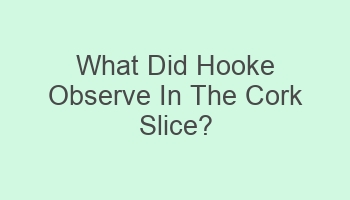What Did Hooke Observe In The Cork Slice?

What Did Hooke Observe In The Cork Slice? Robert Hooke observed cells in a cork slice using a microscope. This groundbreaking discovery revolutionized the field of biology. Hooke’s observations led to the development of cell theory, which states that all living organisms are composed of cells. The cork slice revealed tiny, empty chambers that Hooke named “cells,” derived from the Latin word for “little rooms.” By observing the structure of the cork slice, Hooke laid the foundation for modern microscopy and our understanding of the building blocks of life. This discovery sparked a new era of scientific exploration and paved the way for further advancements in biology and medicine.
Contents
| Robert Hooke observed honeycomb-like structures in cork slice. |
| The structures were actually cell walls of dead plant cells. |
| Hooke coined the term cells to describe these structures. |
| His observations were made using a compound microscope. |
| Hooke’s discovery was published in his book Micrographia. |
- Hooke’s observations revolutionized biology and microscopy.
- The discovery laid the foundation for cell theory in science.
- Cork cells are a common example in biology textbooks.
- Hooke’s work inspired further research in the field of microscopy.
- The cork slice observation was a major breakthrough in science.
What Did Hooke Observe In The Cork Slice?
Robert Hooke observed the structure of a cork slice under a microscope and noticed small compartments that he named “cells.” This discovery revolutionized the way we understand the composition of living organisms.
- Hooke observed that these cells were empty and enclosed by walls, giving them a honeycomb-like appearance.
- The cells were uniform in shape and size, leading Hooke to coin the term “cell” to describe them.
When Did Hooke Make This Observation?
Hooke made this observation in 1665 when he examined a thin slice of cork using a microscope he designed himself. This marked the beginning of the field of cell biology.
| He published his findings in his book “Micrographia,” where he detailed his observations and illustrations of the cork cells. |
Why Was Hooke’s Observation Significant?
The significance of Hooke’s observation lies in the fact that it was the first time that scientists had visual evidence of the existence of cells, which are the building blocks of all living organisms.
- This observation laid the foundation for the development of cell theory, which states that all living organisms are composed of cells.
- It also sparked further research into the structure and function of cells, leading to many important discoveries in biology.
Where Did Hooke Obtain the Cork Slice for His Observation?
Hooke obtained the cork slice from the bark of an oak tree. The cork was chosen for its unique structure, which made it an ideal specimen for microscopy.
| The cork slice was thinly sliced to allow light to pass through and reveal the cell structures within. |
How Did Hooke’s Observation of the Cork Slice Impact Science?
The observation of the cork slice by Hooke had a significant impact on the field of science, particularly in biology and microscopy.
- It led to a better understanding of the structure of plants and other living organisms.
- It also paved the way for the development of more advanced microscopy techniques, allowing scientists to study cells in greater detail.
Who Was Robert Hooke and What Led Him to Make This Observation?
Robert Hooke was a renowned scientist and inventor known for his contributions to various fields, including physics, astronomy, and biology.
| His curiosity and ingenuity led him to design and build his own microscope, which enabled him to make groundbreaking observations like the one in the cork slice. |
Can Hooke’s Observation of the Cork Slice Still be Studied Today?
While Hooke’s original cork slice may no longer exist, the cells he observed have been replicated and studied by scientists using modern microscopy techniques.
- Researchers continue to investigate the structure and function of cells, building upon the foundation laid by Hooke’s groundbreaking observation.
What Other Discoveries Did Hooke Make Using His Microscope?
In addition to his observation of the cork slice, Hooke made many other significant discoveries using his microscope, including observations of fossils, insects, and crystals.
| His work in microscopy helped advance the field of science and laid the groundwork for future discoveries in various disciplines. |
Is Hooke’s Observation of the Cork Slice Taught in Science Classes Today?
Hooke’s observation of the cork slice and his discovery of cells are often included in science curricula to educate students about the history of biology and the development of cell theory.
- Students learn about Hooke’s contributions to science and how his observations revolutionized our understanding of the natural world.